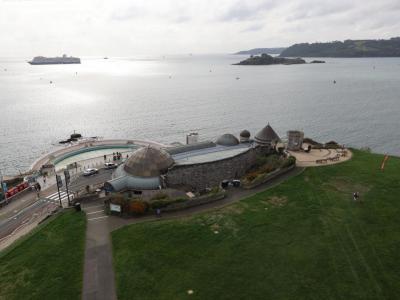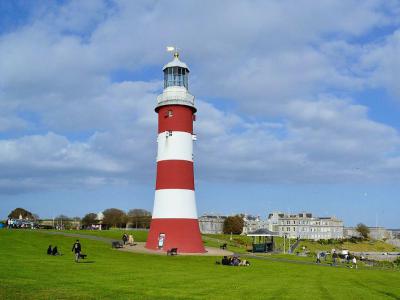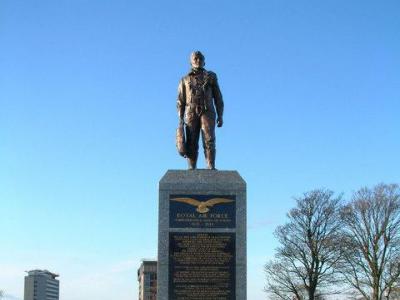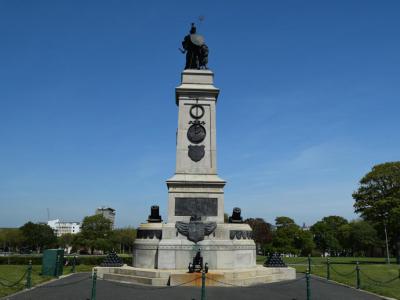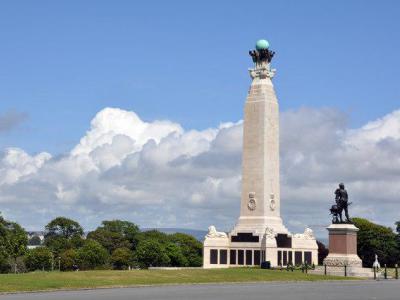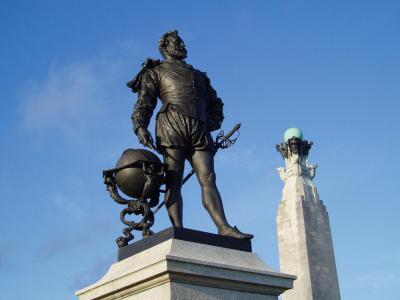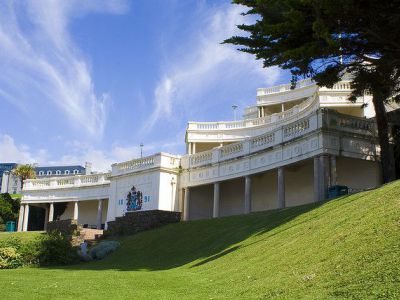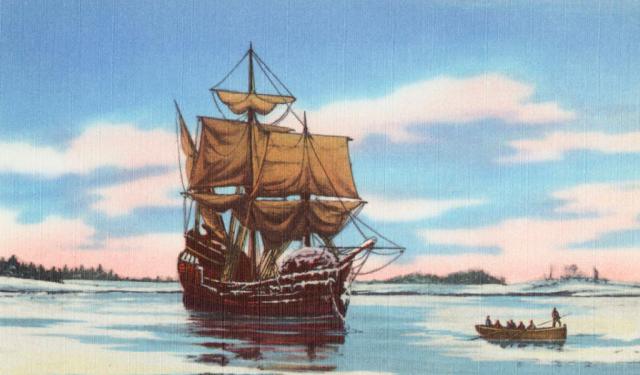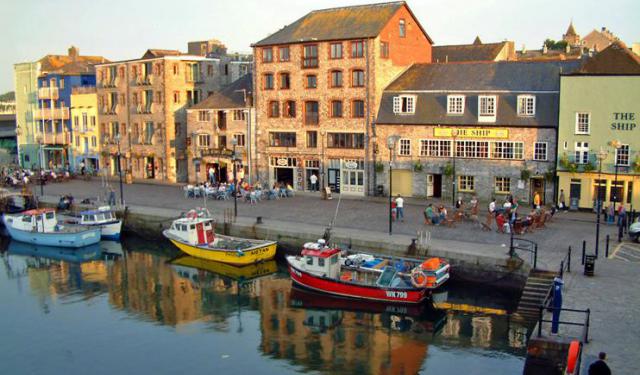Plymouth Hoe Walking Tour (Self Guided), Plymouth
Plymouth Hoe, referred to locally as the Hoe, is a large south-facing open public space in Plymouth with commanding views of Plymouth Sound, Drake's Island, and further afield into Cornwall. The name derives from the Anglo-Saxon word hoh, which means a sloping ridge shaped like an inverted foot and heel.
This part of town has always been a meeting place, where people would come regularly to meet friends and generally enjoy themselves. Notable buildings and statues of various sorts have been on the Hoe for so long that to some they may appear as part of the furniture that the people often walk past without thinking how really special or unusual they are.
A prominent landmark on the Hoe is Smeaton's Tower, the lighthouse, moved here, stone by stone, from the Eddystone Rocks, in 1877.
But Plymouth Hoe is probably best known as the place where Sir Francis Drake famously played the game of bowls before sailing out from Plymouth Sound to engage with the invading Spanish Armada in 1558. The Armada Memorial was placed here in 1888 to celebrate the tercentenary of the event; four years before that, a statue of Drake was opened nearby to commemorate the captain himself, famed as the first Englishman to circumnavigate the world.
There are also several war memorials along the northern side of the Hoe, the largest of which pays tribute to the Royal Navy personnel lost at sea during two world wars. Another one, close by, commemorates the RAF & Allied Air Forces servicemen and -women of the same period.
No trip to Plymouth is complete without a visit to Plymouth Hoe. With the unbeatable views across Plymouth Sound, this is a perfect location to spend a sunny day and explore the multiple historical sites just crying out to be learned about. Luckily, you can do so comfortably, in your good time and at your own pace, with the help of our self-guided walking tour!
This part of town has always been a meeting place, where people would come regularly to meet friends and generally enjoy themselves. Notable buildings and statues of various sorts have been on the Hoe for so long that to some they may appear as part of the furniture that the people often walk past without thinking how really special or unusual they are.
A prominent landmark on the Hoe is Smeaton's Tower, the lighthouse, moved here, stone by stone, from the Eddystone Rocks, in 1877.
But Plymouth Hoe is probably best known as the place where Sir Francis Drake famously played the game of bowls before sailing out from Plymouth Sound to engage with the invading Spanish Armada in 1558. The Armada Memorial was placed here in 1888 to celebrate the tercentenary of the event; four years before that, a statue of Drake was opened nearby to commemorate the captain himself, famed as the first Englishman to circumnavigate the world.
There are also several war memorials along the northern side of the Hoe, the largest of which pays tribute to the Royal Navy personnel lost at sea during two world wars. Another one, close by, commemorates the RAF & Allied Air Forces servicemen and -women of the same period.
No trip to Plymouth is complete without a visit to Plymouth Hoe. With the unbeatable views across Plymouth Sound, this is a perfect location to spend a sunny day and explore the multiple historical sites just crying out to be learned about. Luckily, you can do so comfortably, in your good time and at your own pace, with the help of our self-guided walking tour!
How it works: Download the app "GPSmyCity: Walks in 1K+ Cities" from Apple App Store or Google Play Store to your mobile phone or tablet. The app turns your mobile device into a personal tour guide and its built-in GPS navigation functions guide you from one tour stop to next. The app works offline, so no data plan is needed when traveling abroad.
Plymouth Hoe Walking Tour Map
Guide Name: Plymouth Hoe Walking Tour
Guide Location: England » Plymouth (See other walking tours in Plymouth)
Guide Type: Self-guided Walking Tour (Sightseeing)
# of Attractions: 7
Tour Duration: 1 Hour(s)
Travel Distance: 0.7 Km or 0.4 Miles
Author: VictoriaB
Sight(s) Featured in This Guide:
Guide Location: England » Plymouth (See other walking tours in Plymouth)
Guide Type: Self-guided Walking Tour (Sightseeing)
# of Attractions: 7
Tour Duration: 1 Hour(s)
Travel Distance: 0.7 Km or 0.4 Miles
Author: VictoriaB
Sight(s) Featured in This Guide:
- Plymouth Dome
- Smeaton's Tower
- RAF Monument
- National Armada Memorial
- Plymouth Naval Memorial
- Sir Francis Drake's Statue
- Belvedere
1) Plymouth Dome
The Plymouth Dome is a close neighbor to Smeaton's Tower, the transported lighthouse tower on Plymouth Hoe. The Dome opened as a museum in 1989. Before its opening to the public in July 1988, Queen Elizabeth II unveiled a plaque to commemorate the 400th anniversary of the defeat of the Spanish Armada.
An official opening followed in November, officiated by Bryce Harland, High Commissioner for New Zealand. In 2004 the museum, it is said, drew over 60,000 visitors. However, in 2006 falling visitor numbers led the Plymouth City Council to lease the building to the Wykeham Group, which intended to open a restaurant in one of the exhibition spaces.
This arrangement didn't work out, and the Dome closed for five years. In 2011, celebrity chef Gary Rhodes announced he would reopen the Dome as a restaurant. He opened it in 2013. After Rhodes left in 2016, the "Rhodes & the Dome" became "The Dome." The Restaurant is bistro-style, with a cocktail bar and a live piano.
There are plans involving doing the Dome over again with more ambitious construction, eco-friendly, better landscaping, etc. Perhaps the best alternative is to return it as a visitor center with a restaurant. It commands magnificent views of the harbor and the sea beyond. Together with Smeaton's Tower, it is an attraction not to be missed.
An official opening followed in November, officiated by Bryce Harland, High Commissioner for New Zealand. In 2004 the museum, it is said, drew over 60,000 visitors. However, in 2006 falling visitor numbers led the Plymouth City Council to lease the building to the Wykeham Group, which intended to open a restaurant in one of the exhibition spaces.
This arrangement didn't work out, and the Dome closed for five years. In 2011, celebrity chef Gary Rhodes announced he would reopen the Dome as a restaurant. He opened it in 2013. After Rhodes left in 2016, the "Rhodes & the Dome" became "The Dome." The Restaurant is bistro-style, with a cocktail bar and a live piano.
There are plans involving doing the Dome over again with more ambitious construction, eco-friendly, better landscaping, etc. Perhaps the best alternative is to return it as a visitor center with a restaurant. It commands magnificent views of the harbor and the sea beyond. Together with Smeaton's Tower, it is an attraction not to be missed.
2) Smeaton's Tower (must see)
John Smeaton was an 18th-century mechanical engineer and physicist called the "father" of civil engineering. Smeaton is noted for reviving the ancient Roman art of pouring concrete underwater using hydraulic lime. He designed the lighthouse on the Eddystone Rocks considered his main achievement.
Thirteen miles southwest of Plymouth are the dangerous Eddystone Rocks, notorious for rough weather, stormy sea, and deathly obstacles. Winstanley's Tower of 1698 was the first Eddystone Light. It was designed and built by Henry Winstanley, known for his Waterworks of Hyde Park in London. Made of steel, Winstanley's Tower was replaced by Rudyerd's Tower in 1709.
John Rudyerd was a merchant of Ludgate with a hobby in engineering. His octagonal wooden tower lasted until 1755. It caught fire on a stormy night in December and burned for eight hours. The keeper, 94-year-old Henry Hall, later died. Steel was corruptible, and wood was combustible. Smeaton had new ideas, and he used stone.
Smeaton created his tower based on the shape of an oak tree. He utilized granite for the foundation and facings. The blocks were secured with dovetail joints and marble dowels. The technique used by Smeaton allowed concrete to be set underwater. The lighthouse remained in use until 1877 when the rocks became eroded. Each time a large wave hit, the lighthouse shook from side to side. Smeaton's lighthouse was replaced by Douglass's Tower in 1882.
The 72-foot-high upper part of Smeaton's Tower was disassembled and rebuilt as a memorial to Smeaton on a new base on Plymouth Hoe, overlooking the harbor and the rocks beyond Drake's Island. The Eddystone Light of today is operated automatically. It is controlled by the Trinity House Planning Center in Harwich, Essex.
Thirteen miles southwest of Plymouth are the dangerous Eddystone Rocks, notorious for rough weather, stormy sea, and deathly obstacles. Winstanley's Tower of 1698 was the first Eddystone Light. It was designed and built by Henry Winstanley, known for his Waterworks of Hyde Park in London. Made of steel, Winstanley's Tower was replaced by Rudyerd's Tower in 1709.
John Rudyerd was a merchant of Ludgate with a hobby in engineering. His octagonal wooden tower lasted until 1755. It caught fire on a stormy night in December and burned for eight hours. The keeper, 94-year-old Henry Hall, later died. Steel was corruptible, and wood was combustible. Smeaton had new ideas, and he used stone.
Smeaton created his tower based on the shape of an oak tree. He utilized granite for the foundation and facings. The blocks were secured with dovetail joints and marble dowels. The technique used by Smeaton allowed concrete to be set underwater. The lighthouse remained in use until 1877 when the rocks became eroded. Each time a large wave hit, the lighthouse shook from side to side. Smeaton's lighthouse was replaced by Douglass's Tower in 1882.
The 72-foot-high upper part of Smeaton's Tower was disassembled and rebuilt as a memorial to Smeaton on a new base on Plymouth Hoe, overlooking the harbor and the rocks beyond Drake's Island. The Eddystone Light of today is operated automatically. It is controlled by the Trinity House Planning Center in Harwich, Essex.
3) RAF Monument
The Royal Air Force and Allied Air Forces Monument on Plymouth Hoe is erected in memoriam of the brave men and women who served in the Allied Air Forces during the period of 1939-45, both in the air and on the ground, including those of the British Army Air Corps, Fleet Air Arm and the Air Transport Auxilliary.
The monument's main body – a two-stepped base and surmounting square plinth – is made out of granite, and is topped with a 6-foot tall bronze statue of the Unknown Airman, sculpted by Mrs. Pamela Taylor. Three tablets with dedicatory inscriptions are set into the seaward face of the plinth, and one more tablet is at the foot of the steps. The Airman in flying kit is depicted gazing out to sea, holding his parachute in his right hand.
It was the inspiration of Mr. Jim Davis, a former rear gunner on the Lancaster during the Second World War. He and the wartime commander of the Pathfinder Force of Bomber Command, Air Vice-Marshal Don Bennett, fought for over nine years to have this monument erected on the Hoe. The ashes of Don Bennett are buried right here, at the base.
RAF Monument is the only international air memorial in the world. Many of the airmen and -women to whom it is dedicated were from the countries which were not directly involved in WWII hostilities. Nationals from as far afield as the Caribbean islands, Iceland and Southern Ireland (Eire) served within the RAF.
The monument was unveiled on September 3rd 1989, marking the 50th Anniversary of the declaration of the Second World War. Among the several hundred veterans who paraded that day were representatives of 17 countries, including the USA, the USSR, Poland, Czechoslovakia, the Netherlands, South Africa and Zimbabwe.
The monument's main body – a two-stepped base and surmounting square plinth – is made out of granite, and is topped with a 6-foot tall bronze statue of the Unknown Airman, sculpted by Mrs. Pamela Taylor. Three tablets with dedicatory inscriptions are set into the seaward face of the plinth, and one more tablet is at the foot of the steps. The Airman in flying kit is depicted gazing out to sea, holding his parachute in his right hand.
It was the inspiration of Mr. Jim Davis, a former rear gunner on the Lancaster during the Second World War. He and the wartime commander of the Pathfinder Force of Bomber Command, Air Vice-Marshal Don Bennett, fought for over nine years to have this monument erected on the Hoe. The ashes of Don Bennett are buried right here, at the base.
RAF Monument is the only international air memorial in the world. Many of the airmen and -women to whom it is dedicated were from the countries which were not directly involved in WWII hostilities. Nationals from as far afield as the Caribbean islands, Iceland and Southern Ireland (Eire) served within the RAF.
The monument was unveiled on September 3rd 1989, marking the 50th Anniversary of the declaration of the Second World War. Among the several hundred veterans who paraded that day were representatives of 17 countries, including the USA, the USSR, Poland, Czechoslovakia, the Netherlands, South Africa and Zimbabwe.
4) National Armada Memorial
The National Armada Memorial stands as a proud testament on Plymouth Hoe, commemorating the 300th anniversary of the first sighting of the Spanish Armada by English captains stationed in the city. This event marked a pivotal moment in English history when the formidable Spanish Armada attempted an unsuccessful naval invasion.
News of the Armada’s approach reached Plymouth on the afternoon of 19 July 1588, and the fleet came into sight the following day. According to tradition, the English captains were engaged in a game of bowls on Plymouth Hoe when the tidings arrived. The famed commander Sir Francis Drake reportedly remarked, “There is time enough to play the game out first and thrash the Spaniards afterward,” epitomizing the legendary calm and confidence of the English forces.
The Armada Memorial's foundation stone was laid on 19 July 1888, marking 300 years since the first sighting. The event drew large crowds, with thousands arriving by excursion trains and a public holiday celebrated with a ceremony and banquet at the Guildhall. It was inaugurated on 21 October 1890 by Duke Alfred of Edinburgh, featuring civic pride and naval displays.
Designed by architect Herbert Gribble and sculpted by William Charles May, the granite structure features an octagonal base with steps leading up to a tall square plinth. This plinth is adorned with a shield surrounded by drapes and a crown, alongside a panel depicting the Battle of the Armada with the inscription “HE BLEW WITH HIS WINDS AND THEY WERE SCATTERED.” Additionally, the plinth includes a wreathed medallion and a chest adorned with a sculpted head believed to represent the Spanish admiral Sedonia.
Crowning the monument is an imposing 11-foot bronze statue of Britannia, a symbolic figure representing Great Britain, with a vigilant lion at her side. The National Armada Memorial had the patronage of Queen Victoria, further underscoring its importance as a national symbol.
In 1975, the memorial was designated a listed monument, ensuring its preservation as a significant piece of English heritage. The National Armada Memorial remains a powerful reminder of a defining moment in maritime history and a tribute to the valor and resilience of the nation.
News of the Armada’s approach reached Plymouth on the afternoon of 19 July 1588, and the fleet came into sight the following day. According to tradition, the English captains were engaged in a game of bowls on Plymouth Hoe when the tidings arrived. The famed commander Sir Francis Drake reportedly remarked, “There is time enough to play the game out first and thrash the Spaniards afterward,” epitomizing the legendary calm and confidence of the English forces.
The Armada Memorial's foundation stone was laid on 19 July 1888, marking 300 years since the first sighting. The event drew large crowds, with thousands arriving by excursion trains and a public holiday celebrated with a ceremony and banquet at the Guildhall. It was inaugurated on 21 October 1890 by Duke Alfred of Edinburgh, featuring civic pride and naval displays.
Designed by architect Herbert Gribble and sculpted by William Charles May, the granite structure features an octagonal base with steps leading up to a tall square plinth. This plinth is adorned with a shield surrounded by drapes and a crown, alongside a panel depicting the Battle of the Armada with the inscription “HE BLEW WITH HIS WINDS AND THEY WERE SCATTERED.” Additionally, the plinth includes a wreathed medallion and a chest adorned with a sculpted head believed to represent the Spanish admiral Sedonia.
Crowning the monument is an imposing 11-foot bronze statue of Britannia, a symbolic figure representing Great Britain, with a vigilant lion at her side. The National Armada Memorial had the patronage of Queen Victoria, further underscoring its importance as a national symbol.
In 1975, the memorial was designated a listed monument, ensuring its preservation as a significant piece of English heritage. The National Armada Memorial remains a powerful reminder of a defining moment in maritime history and a tribute to the valor and resilience of the nation.
5) Plymouth Naval Memorial
The Plymouth Naval Memorial, prominently located on The Hoe and overlooking the scenic Plymouth Sound stands as a solemn tribute to British and Commonwealth sailors who perished during the First and Second World Wars and have no known graves.
The origins of the memorial trace back to the aftermath of World War I, when the Royal Navy sought a meaningful way to honor sailors and Royal Marines lost at sea. An Admiralty committee proposed the construction of memorials at Britain’s three major naval ports: Plymouth, Chatham, and Portsmouth. Sir Robert Lorimer was appointed as the designer for these significant monuments, with sculptural work by Henry Poole. The Plymouth Memorial was unveiled on July 29, 1924, marking a significant moment of remembrance for the nation.
Following the conclusion of World War II, the memorials required expansion to include the names of those who had fallen during the subsequent conflict. The architectural enhancements at Plymouth were overseen by Sir Edward Maufe, with sculptural contributions by Charles Wheeler and William McMillan.
The Plymouth Naval Memorial commemorates a total of 7,251 sailors from World War I and 15,933 from World War II. These names represent not only those from the United Kingdom but also sailors from Australia, South Africa, and India, emphasizing the breadth of Commonwealth contributions and sacrifices.
Central to the design is an imposing obelisk, bearing the names of the fallen in a poignant arrangement. The names of those who died in the First World War are inscribed on panels affixed to the obelisk’s base, while the panels for the Second World War are integrated into the surrounding wall. Within each year of death, the names are organized by service branch, followed by rank and surname, creating a structured and respectful memorial to those who served and were lost.
The Plymouth Naval Memorial continues to be a place of remembrance and reflection, reminding visitors of the profound human cost of war and the enduring legacy of those who served their country at sea.
The origins of the memorial trace back to the aftermath of World War I, when the Royal Navy sought a meaningful way to honor sailors and Royal Marines lost at sea. An Admiralty committee proposed the construction of memorials at Britain’s three major naval ports: Plymouth, Chatham, and Portsmouth. Sir Robert Lorimer was appointed as the designer for these significant monuments, with sculptural work by Henry Poole. The Plymouth Memorial was unveiled on July 29, 1924, marking a significant moment of remembrance for the nation.
Following the conclusion of World War II, the memorials required expansion to include the names of those who had fallen during the subsequent conflict. The architectural enhancements at Plymouth were overseen by Sir Edward Maufe, with sculptural contributions by Charles Wheeler and William McMillan.
The Plymouth Naval Memorial commemorates a total of 7,251 sailors from World War I and 15,933 from World War II. These names represent not only those from the United Kingdom but also sailors from Australia, South Africa, and India, emphasizing the breadth of Commonwealth contributions and sacrifices.
Central to the design is an imposing obelisk, bearing the names of the fallen in a poignant arrangement. The names of those who died in the First World War are inscribed on panels affixed to the obelisk’s base, while the panels for the Second World War are integrated into the surrounding wall. Within each year of death, the names are organized by service branch, followed by rank and surname, creating a structured and respectful memorial to those who served and were lost.
The Plymouth Naval Memorial continues to be a place of remembrance and reflection, reminding visitors of the profound human cost of war and the enduring legacy of those who served their country at sea.
6) Sir Francis Drake's Statue
The bronze statue of Sir Francis Drake in Plymouth stands as a prominent tribute to one of the most renowned seafarers of his era. Overlooking the iconic Hoe, this 10-foot tall monument was sculpted by Joseph Edgar Boehm and unveiled on February 14, 1884, in the presence of Lady Fuller Drake, a distant relative of the celebrated explorer.
Captain Francis Drake holds the distinction of being the first Englishman to successfully circumnavigate the globe. Commissioned in secret by Queen Elizabeth I in 1577, Drake embarked on an ambitious voyage aimed at disrupting Spanish interests on the Pacific coast of the Americas. His expedition was marked by daring raids on Spanish ports and his eventual return to England in 1580, laden with valuable spices and treasure. In recognition of his accomplishments, Elizabeth I knighted Drake in 1581, the same year he was appointed Mayor of Plymouth and subsequently served as a member of parliament.
Drake’s legacy is further cemented by his pivotal role in defending England during the Spanish Armada’s attempted invasion. According to popular lore, Drake was engaged in a game of bowls on Plymouth Hoe on July 20, 1588, when news of the Armada’s approach arrived. Legend has it that he nonchalantly continued his game, confident in the knowledge that the English fleet could not set sail immediately due to prevailing wind and tide conditions. When the time came, Drake led the fleet to victory, adding to his storied reputation.
In 1979, marking the 400th anniversary of Drake’s circumnavigation, the Sir Francis Drake Commission of California gifted Plymouth with a commemorative plaque, recognizing his landing in Marin County, California, in June 1579. This plaque has since been integrated into the base of the statue.
Captain Francis Drake holds the distinction of being the first Englishman to successfully circumnavigate the globe. Commissioned in secret by Queen Elizabeth I in 1577, Drake embarked on an ambitious voyage aimed at disrupting Spanish interests on the Pacific coast of the Americas. His expedition was marked by daring raids on Spanish ports and his eventual return to England in 1580, laden with valuable spices and treasure. In recognition of his accomplishments, Elizabeth I knighted Drake in 1581, the same year he was appointed Mayor of Plymouth and subsequently served as a member of parliament.
Drake’s legacy is further cemented by his pivotal role in defending England during the Spanish Armada’s attempted invasion. According to popular lore, Drake was engaged in a game of bowls on Plymouth Hoe on July 20, 1588, when news of the Armada’s approach arrived. Legend has it that he nonchalantly continued his game, confident in the knowledge that the English fleet could not set sail immediately due to prevailing wind and tide conditions. When the time came, Drake led the fleet to victory, adding to his storied reputation.
In 1979, marking the 400th anniversary of Drake’s circumnavigation, the Sir Francis Drake Commission of California gifted Plymouth with a commemorative plaque, recognizing his landing in Marin County, California, in June 1579. This plaque has since been integrated into the base of the statue.
7) Belvedere
Lying on the seaward side of Plymouth Hoe and originally known as the Public Shelter, the Belvedere is more commonly referred to as the 'Wedding Cake'. The nick is due to the layered structure of the building, with an open colonnaded front and a pompous staircase.
As for the actual name, Belvedere, it derives from the two Italian words: 'bel' which means 'beautiful' and 'vedere' meaning 'to see/view'. Indeed, this fine terraced summer house, which once served as the ornate entrance to Promenade Pier (one of the Hoe’s greatest attractions), affords visitors a rather breathtaking view of Plymouth’s beautiful coastline.
The Wedding Cake has three levels and under its steps you can actually see the remains of the old Plymouth Promenade Pier, where it once met the land. The Belvedere was constructed in 1891 and tradition says that the pillars of its two upper tiers are reused 17th-century granite Tuscan columns taken from the old Market.
Throughout the 1800s, regular political meetings were held right below the Belvedere, in what used to be the so-called the Bull Ring. In the early 1900s, people would come here to meet friends and go out for a dance or a concert at the Pier. As well as tea dances and musical concerts, another event that drew crowds to the Wedding Cake and the surrounding area, was a swimming regatta in the Sound. Thousands of people would gather to watch the swimming, for which reason, some of the steps down on West Hoe are bum-sized, i.e. sized to one's bottom so as to fit as many people in as possible on the steps to watch the regatta.
Unfortunately, a lot of Plymouth was bombed in WWII, and the Pier caught fire during the Plymouth Blitz in 1941. What was left of it had to be demolished in the early 1950s, so the Wedding Cake is the only bit of it that lives on, much as the tales of the Pier's former splendour.
As for the actual name, Belvedere, it derives from the two Italian words: 'bel' which means 'beautiful' and 'vedere' meaning 'to see/view'. Indeed, this fine terraced summer house, which once served as the ornate entrance to Promenade Pier (one of the Hoe’s greatest attractions), affords visitors a rather breathtaking view of Plymouth’s beautiful coastline.
The Wedding Cake has three levels and under its steps you can actually see the remains of the old Plymouth Promenade Pier, where it once met the land. The Belvedere was constructed in 1891 and tradition says that the pillars of its two upper tiers are reused 17th-century granite Tuscan columns taken from the old Market.
Throughout the 1800s, regular political meetings were held right below the Belvedere, in what used to be the so-called the Bull Ring. In the early 1900s, people would come here to meet friends and go out for a dance or a concert at the Pier. As well as tea dances and musical concerts, another event that drew crowds to the Wedding Cake and the surrounding area, was a swimming regatta in the Sound. Thousands of people would gather to watch the swimming, for which reason, some of the steps down on West Hoe are bum-sized, i.e. sized to one's bottom so as to fit as many people in as possible on the steps to watch the regatta.
Unfortunately, a lot of Plymouth was bombed in WWII, and the Pier caught fire during the Plymouth Blitz in 1941. What was left of it had to be demolished in the early 1950s, so the Wedding Cake is the only bit of it that lives on, much as the tales of the Pier's former splendour.
Walking Tours in Plymouth, England
Create Your Own Walk in Plymouth
Creating your own self-guided walk in Plymouth is easy and fun. Choose the city attractions that you want to see and a walk route map will be created just for you. You can even set your hotel as the start point of the walk.
Pilgrim Fathers Trail
Back in the early 17th century, a group of English Puritans – nowadays reverently referred to as the Pilgrim Fathers – fled religious persecution in their homeland and established a colony in North America that later became known as Plymouth, Massachusetts. The Pilgrims embarked on their perilous journey across the Atlantic from Plymouth, England in 1620 aboard a ship called the Mayflower,... view more
Tour Duration: 1 Hour(s)
Travel Distance: 0.5 Km or 0.3 Miles
Tour Duration: 1 Hour(s)
Travel Distance: 0.5 Km or 0.3 Miles
Plymouth Introduction Walking Tour
Plymouth's early history began in the Bronze Age when the first settlement emerged at Mount Batten. It is mentioned in Ptolemy's Geographia as a maritime outpost exporting bronze mirrors.
The settlement was a major port in the southwest of England in Roman times. It was surpassed as a port in the ninth century by the nearby wealthier village of Sutton, later called Plymouth.
... view more
Tour Duration: 1 Hour(s)
Travel Distance: 1.9 Km or 1.2 Miles
The settlement was a major port in the southwest of England in Roman times. It was surpassed as a port in the ninth century by the nearby wealthier village of Sutton, later called Plymouth.
... view more
Tour Duration: 1 Hour(s)
Travel Distance: 1.9 Km or 1.2 Miles
The Most Popular Cities
/ view all



